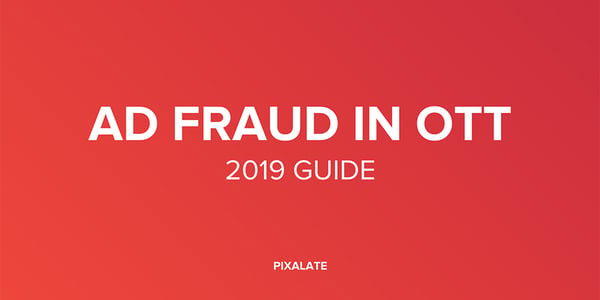Sign up for our blog to stay updated with new stats, trends, and analysis of digital ad fraud.

This week's review of ad fraud and quality in the digital advertising space.

"Advertising fraud in over-the-top video is poised to grow in coming years, as fraudsters follow media consumption habits and higher CPMs to streaming video platforms," wrote MediaPost, citing recent Pixalate research into OTT ad fraud. "As the shift to video continues, and fraudsters adjust their strategies, those concerns are likely to escalate over the coming years," the article added.

New York Magazine dives into the world of fake — well, everything — on the internet. "How much of the internet is fake?" the article asks. "Studies generally suggest that, year after year, less than 60 percent of web traffic is human; some years, according to some researchers, a healthy majority of it is bot."

"The TV and OTT landscapes continue to shift and slide as consumers adopt digital video and streaming options, and the companies producing long-form content make bets on where audiences will spend their time," wrote eMarketer before presenting eight digital video market predictions for 2019. "Connected TV advertising will continue to scale up" is one of their predictions, and eMarketer also believes cord-cutting will accelerate.

AdExchanger reminds the digital ad industry that the General Data Protection Regulation (GDPR) — a hot topic through the first half of 2018 — will likely have big impact in 2019. "Freight trains take time to build steam," AdExchanger wrote. "That’s your metaphor for what’s to come in 2019 for the General Data Protection Regulation."
"[T]here was still a lot of groundwork laid [in 2018] and many hints dropped about what DPAs [data protection authorities] will prioritize in 2019," wrote AdExchanger. "Data security and consent, particularly as it pertains to advertising and location tracking, top the agenda," the article noted, citing Ronan Tigner, an associate at Morrison & Foerster law firm. said.

Security Boulevard runs through exactly how cybercriminals profit from clicks in the world of online advertising. "Ad fraud generates artificial impressions or clicks on a targeted website for profit. This is a highly skilled group of cybercriminals that is capable of building and maintaining a massive infrastructure of infected devices in a botnet," wrote Security Boulevard. "Different devices are leveraged for different types of ad fraud but generally, PC-based ad fraud campaigns are capable of silently opening an internet browser on the victim’s computer and clicking on an advertisement."
Sign up for our blog to stay updated with new stats, trends, and analysis of digital ad fraud.
*By entering your email address and clicking Subscribe, you are agreeing to our Terms of Use and Privacy Policy.
These Stories on Weekly Recaps
*By entering your email address and clicking Subscribe, you are agreeing to our Terms of Use and Privacy Policy.

Disclaimer: The content of this page reflects Pixalate’s opinions with respect to the factors that Pixalate believes can be useful to the digital media industry. Any proprietary data shared is grounded in Pixalate’s proprietary technology and analytics, which Pixalate is continuously evaluating and updating. Any references to outside sources should not be construed as endorsements. Pixalate’s opinions are just that - opinion, not facts or guarantees.
Per the MRC, “'Fraud' is not intended to represent fraud as defined in various laws, statutes and ordinances or as conventionally used in U.S. Court or other legal proceedings, but rather a custom definition strictly for advertising measurement purposes. Also per the MRC, “‘Invalid Traffic’ is defined generally as traffic that does not meet certain ad serving quality or completeness criteria, or otherwise does not represent legitimate ad traffic that should be included in measurement counts. Among the reasons why ad traffic may be deemed invalid is it is a result of non-human traffic (spiders, bots, etc.), or activity designed to produce fraudulent traffic.”

